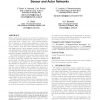Free Online Productivity Tools
i2Speak
i2Symbol
i2OCR
iTex2Img
iWeb2Print
iWeb2Shot
i2Type
iPdf2Split
iPdf2Merge
i2Bopomofo
i2Arabic
i2Style
i2Image
i2PDF
iLatex2Rtf
Sci2ools
MOBIHOC
2008
ACM
2008
ACM
Efficient binary schemes for training heterogeneous sensor and actor networks
Sensor networks are expected to evolve into long-lived, autonomous networked systems whose main mission is to provide in-situ users ? called actors ? with real-time information in support of specific goals supportive of their mission. The network is populated with a heterogeneous set of tiny sensors. The free sensors alternate between sleep and awake periods, under program control in response to computational and communication needs. The periodic sensors alternate between sleep periods and awake periods of predefined lengths, established at the fabrication time. The architectural model of an actor-centric network used in this work comprises in addition to the tiny sensors a set of mobile actors that organize and manage the sensors in their vicinity. We take the view that the sensors deployed are anonymous and unaware of their geographic location. Importantly, the sensors are not, a priori, organized into a network. It is, indeed, the interaction between the actors and the sensor popul...
| Added | 24 Dec 2009 |
| Updated | 24 Dec 2009 |
| Type | Conference |
| Year | 2008 |
| Where | MOBIHOC |
| Authors | Ferruccio Barsi, Alfredo Navarra, Maria Cristina Pinotti, Christian Lavault, Vlady Ravelomanana, Stephan Olariu, Alan A. Bertossi |
Comments (0)

